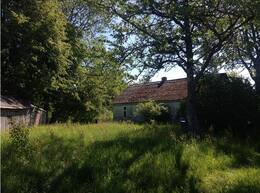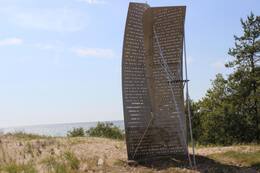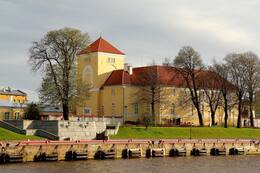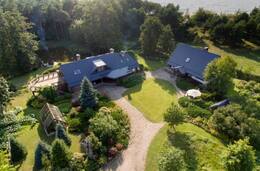The last birthday celebration of Kārlis Skalbe on the Kurzeme coast
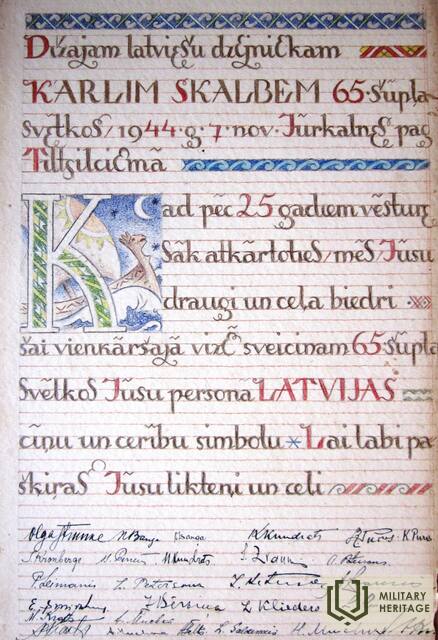
On November 7, 1944, a bright mood was brought to the Latvian refugee settlement on the Kurzeme coast by the commemorations of the poet Kārlis Skalbe’s 65th birthday in the “Laukgaļi” in Jūrkalne. Just four days later, Kārlis Skalbe set off by boat to Sweden as a refugee. It was the day when Kārlis Skalbe celebrated his birthday for the last time.
“In the grey everyday life of refugees, an unforgettable, bright experience was the commemoration of the 65th birthday of poet Kārlis Skalbe in Jūrkalne’s “Laukgaļi”. Painter Niklāvs Strunke had already started preparing an address for the poet’s 65th anniversary on November 7 in “Grīnieki”. His work was not easy – small, dark fishermen’s rooms, and there was always movement, crowding, noise around. [..] On November 7, the entire refugee family, both individually and in groups, visited the beautiful jeweler for Latvia – the great poet Kārlis Skalbe. No valuable gifts were presented, as sometimes would have happened and would have been appropriate under other circumstances, no eulogies were given, however, each greeter brought the great jeweler the warmth of his Latvian heart and some little thing useful for the refugees’ daily needs. The sick poet (he was suffering from kidney disease) with his wife, daughter, son-in-law and grandson Andrejs had a separate small room in “Laukgaļi”. The darkness of the autumn evenings was dispelled only by the tip of a candle. An engineer and an agronomist had jointly brought a bottle of kerosene as a gift.
FJ Šteinmanis. Ventspils Communications Group - “Swedish Ships”. Ventspils 700. Collection of Writings and Memories, Toronto, 1990, p. 126.
Related timeline
Related topics
Related objects
"Laukgaļi" houses, the residence of the writer Kārlis Skalbe
“Laukgaļi” in Jūrkalne parish, the place where writer Kārlis Skalbe stayed in October - November 1944, while waiting for a refugee boat to Sweden.
Writer Kārlis Skalbe (1879–1945) was a member of the Latvian Provisional National Council and the Latvian People's Council, a deputy of the Constitutional Assembly of the Republic of Latvia and the 1st and 4th Saeima. During the German occupation, he was the editor-in-chief of the literary magazine "Latvju Mēnešraksts", one of the signatories of the LCP memorandum of March 17, 1944.
On November 11, 1944, she fled to Sweden. She died in 1945 in Stockholm.
Memorial sign for refugees "Sail of Hope" in Jūrkalne
The "Sail of Hope" commemorative sign for the World War II refugees who crossed the Baltic Sea by boat to the island of Gotland in Sweden in 1944 and 1945. The memorial is located in Osvalki on the dunes between the sea and Ventspils-Liepaja highway, near the public transport stop "Kaijas". It was created by sculptor Ģirts Burvis, who realised it as a sail of hope symbolising the memory of Latvian refugees.
Between autumn 1944 and spring 1945, fearing the renewed Soviet occupation but unwilling to evacuate to a devastated and threatened Germany, some Latvian citizens tried to reach the nearest neutral country, Sweden, by sea. Some of the boats were organised by the Latvian Central Council with the help of the Western Allied countries, which resulted in one of the largest refugee concentration points in Jūrkalnes parish. Besides the boats organised by the Latvian Central Council, other boats were also taken across the sea. It is estimated that about 5000 persons managed to cross the sea. The number of deaths is unknown, as no records were kept of refugees leaving the Kurzeme coast.
The voyages were dangerous because the refugees were threatened by German patrols on the coast and at sea, sea mines, Soviet aircraft and warships, as well as storms, as the crossings often took place in unsuitable and overloaded cutters and boats without sufficient fuel and food supplies, sea charts and navigational instruments. Departures from Latvia were carried out in secret. The destination of the boats was the island of Gotland, and the journeys most often started on the west coast of Courland (from Jūrkalne to Gotland is 90 nautical miles or about 170 kilometres as the crow flies).
Prison in the Livonian Order Castle during World War II
Several members of the LCP Ventspils communications group and refugee boat operators were detained in the prison established in the Livonian Order Castle in 1944-1945.
Memories of the boatman Žanis Fonzovs: “Two boats left Sweden - “Krīvs” and “Zvejnieks”. I was on “Zvejnieks”, and the crew included Saulīte and Grunti. [..] The weather was beautiful, I was sailing so inconspicuously, not very high. I immediately saw - I was in Morse code. The boat was approaching. I went down to the engine room, because in addition to Saulīte's papers, I also had letters from the arrivals to relatives in Latvia and the collected weapons in a bag. I threw the letters and papers into that bag of weapons and everything overboard.. What then! The boat approached ours and the Germans asked for our driving permits. [..] So on October 21, the Germans took us with the entire “Zvejnieks” to Ventspils. They took us to prison. There were about 30 people in the room. I had a sheepskin coat on my back, I put it on the floor and put it on myself, but I had not slept last night. On the second or third day, they called us out for questioning. We had agreed to say that we were refugees on our way to Germany. I had just wanted to go to Lielirbe to follow my friend. It seems that they believed us then. [..] But then the situation in Ventspils changed: the city was taken over by the military administration, and we were called in for questioning a second time. It was worse, because they showed us a box of Swedish matches and a piece of kroon that were allegedly found on the boat. One of the interrogators was a Latvian, and he even beheaded us for telling the whole truth. We saw that the fairy tale had ended, we simply had to confess.
The road to the "Grīnieki" house in Vārve parish
The road to the “Grīnieki” houses in Vārve parish, where in 1944 one of the main settlements for boat refugees on the Kurzeme coast was located.
Memories of boatman V. Jurjakas: “Entering the “Grīnieki” yard, everything looks very normal. A quiet country house, not a soul, probably people in the sun. [..] It turned out that not only the “Grīnieki” residential house was full of people, but all the buildings were full. The barn, the granary, the hayloft and the bathhouse. I met one or two acquaintances, because it was time to leave our land. [..] The nutritional situation was not critical, but quite poor. [..] In the evening, the refugee caravan began to move towards the seashore. I warned everyone in advance not to come out of the bushes by the seashore, because there were coast guard dugouts and observation posts nearby. It was a large caravan, because about 200 people were going to the seashore. There was no hope that everyone would arrive on time. The evening was not very dark, and I was able to review the activities of the entire group. The most striking were the large "When people lived in "Grīnieki", they didn't see them, but now, when they were brought into the light, they only saw this. The goods alone required a whole boat. 3-4 two-horse carts were loaded with goods, followed by people. [..] We waited for the boat for a long time, but it didn't come. The whole caravan had to turn back. It was very dark."
Memorial sign for refugees "Sail of Hope" in Jūrkalne
The "Sail of Hope" commemorative sign for the World War II refugees who crossed the Baltic Sea by boat to the island of Gotland in Sweden in 1944 and 1945. The memorial is located in Osvalki on the dunes between the sea and Ventspils-Liepaja highway, near the public transport stop "Kaijas". It was created by sculptor Ģirts Burvis, who realised it as a sail of hope symbolising the memory of Latvian refugees.
Between autumn 1944 and spring 1945, fearing the renewed Soviet occupation but unwilling to evacuate to a devastated and threatened Germany, some Latvian citizens tried to reach the nearest neutral country, Sweden, by sea. Some of the boats were organised by the Latvian Central Council with the help of the Western Allied countries, which resulted in one of the largest refugee concentration points in Jūrkalnes parish. Besides the boats organised by the Latvian Central Council, other boats were also taken across the sea. It is estimated that about 5000 persons managed to cross the sea. The number of deaths is unknown, as no records were kept of refugees leaving the Kurzeme coast.
The voyages were dangerous because the refugees were threatened by German patrols on the coast and at sea, sea mines, Soviet aircraft and warships, as well as storms, as the crossings often took place in unsuitable and overloaded cutters and boats without sufficient fuel and food supplies, sea charts and navigational instruments. Departures from Latvia were carried out in secret. The destination of the boats was the island of Gotland, and the journeys most often started on the west coast of Courland (from Jūrkalne to Gotland is 90 nautical miles or about 170 kilometres as the crow flies).
"Bambaļi" houses - one of the main accommodation places for boat refugees
The restored “Bambaļi” houses in Ošvalki, Jūrkalne parish, which in 1944 was one of the main places of accommodation for boat refugees on the Kurzeme coast.
Memories of boat refugee Kārlis Draviņš: ““Bambaļi” were old, small, very run-down houses in Jūrkalne parish, about 40 kilometers from Ventspils. [..] Small fields spread around in a damp place, but on the other side an old, overgrown dune wrapped itself around it. The sea gurgled a little behind it - the houses were right next to the sea. On the other side, half a kilometer away, the Pāvilosta-Užava highway ran, but the road to the houses was not easy to drive on, which is why the Germans could not be everyday guests here. The place where boats were waiting was easily accessible - a small forest clearing on a high bank. [..]
The owner of "Bambaļi" and her group, who were also waiting for the "movement of the water", lived in two rooms facing the sea, but the group of refugees lived at the other end of the house, also in two rooms. They shared the kitchen. The hallway between the two ends was stuffed with the refugees' many belongings. The rooms were filled with straw, which was spread out along the walls. On each side of the room was one bed, where a mother and her children slept. The straw beds were covered with sheets or something else during the day. They came out to sit or sleep in them during the day, because there was nowhere else to stay. [..] The days passed monotonously, one after the other. They got up on command, there was no hurry. When the communal breakfast was eaten, some went to play cards, some took up fortune-telling, while others tried to read. Some had to do household chores - fetch firewood, water.





